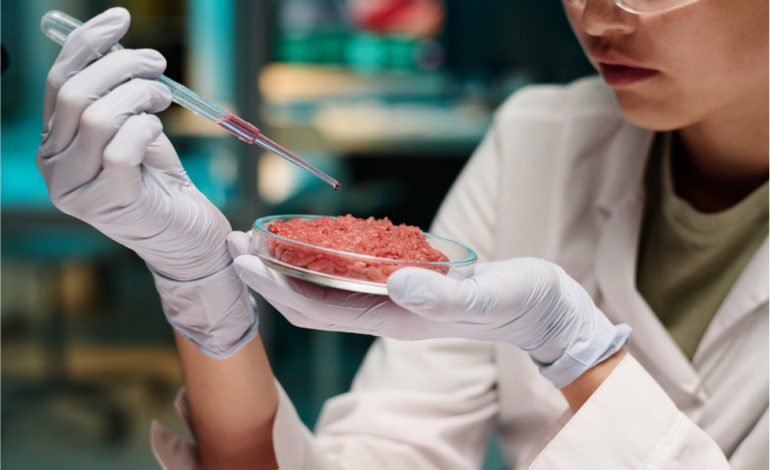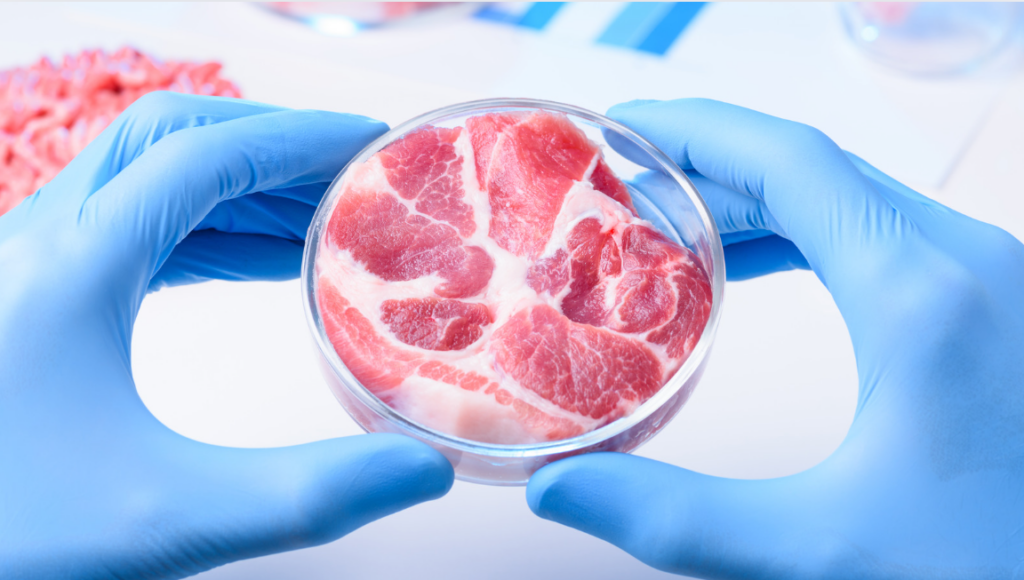From Petri Dish to Plate: The Rise of Lab-Grown Meat and its Impact on the Future of Food

Introduction
The food industry is on the brink of a revolution with the rise of lab-grown meat, also known as cultured or cell-based meat. This innovative approach to meat production involves cultivating animal cells in a controlled environment to create meat without the need for traditional animal farming. As the demand for sustainable and ethical food options grows, lab-grown meat is poised to play a significant role in the future of food. This article delves into the rise of lab-grown meat, its potential benefits, challenges, and the reasons behind its increasing popularity.
Understanding Lab-Grown Meat
What is Lab-Grown Meat?
Lab-grown meat is produced by cultivating animal cells in a bioreactor. The process begins with extracting a small sample of animal cells, which are then placed in a nutrient-rich culture medium. These cells multiply and differentiate into muscle tissue, creating meat that is biologically identical to traditional meat.
The Science Behind Lab-Grown Meat
The production of lab-grown meat involves several steps:
- Cell Extraction: Obtaining a small sample of animal cells, often stem cells, which have the ability to differentiate into various cell types.
- Cell Culturing: Placing the cells in a bioreactor with a culture medium that provides the necessary nutrients for growth.
- Cell Proliferation: Allowing the cells to multiply and form muscle fibers.
- Tissue Structuring: Using scaffolding techniques to give the tissue the structure and texture of conventional meat.
- Harvesting: Collecting the cultured meat for processing and consumption.
The Popularity of Lab-Grown Meat

Addressing Environmental Concerns
Traditional livestock farming is associated with significant environmental impacts, including greenhouse gas emissions, deforestation, and water usage. Lab-grown meat offers a more sustainable alternative by:
- Reducing Emissions: Producing lab-grown meat generates fewer greenhouse gases compared to conventional meat production.
- Conserving Water: Cultured meat requires significantly less water than raising livestock.
- Preserving Land: Eliminating the need for large-scale animal farming reduces the demand for agricultural land, helping to protect natural habitats.
Ethical Considerations
The ethical concerns surrounding animal welfare have driven many consumers to seek alternatives to traditional meat. Lab-grown meat addresses these concerns by:
- Eliminating Slaughter: Producing meat without the need to kill animals, thus avoiding animal suffering.
- Reducing Animal Farming: Decreasing the demand for livestock farming, which is often associated with poor animal living conditions.
Health Benefits
Lab-grown meat has the potential to offer several health benefits, including:
- Controlled Content: The ability to control the composition of the meat, such as fat content and nutrient levels, to produce healthier products.
- Eliminating Contaminants: Reducing the risk of contamination with pathogens and antibiotics commonly found in conventional meat.
The Trend of Reboots in Food Industry
Nostalgia and Innovation
The trend of reboots in various industries, including food, is driven by a blend of nostalgia and innovation. In the case of lab-grown meat, this trend is evident in the way traditional concepts of meat consumption are being reimagined through cutting-edge technology.
Meeting Modern Demands
Reboots like lab-grown meat address the modern consumer’s demand for:
- Sustainability: Providing eco-friendly food options that align with environmental values.
- Ethical Consumption: Offering products that minimize harm to animals and promote humane practices.
- Health Consciousness: Catering to the growing awareness of healthy eating habits and nutritional content.
Benefits of Lab-Grown Meat
Environmental Impact
Lab-grown meat production significantly reduces the environmental footprint associated with traditional livestock farming. Key benefits include:
- Lower Greenhouse Gas Emissions: Cultured meat produces up to 96% fewer greenhouse gases compared to conventional meat.
- Water Conservation: It requires up to 90% less water than traditional meat production.
- Land Use Efficiency: Lab-grown meat needs 99% less land, helping to preserve natural ecosystems and biodiversity.
Ethical Advantages
The ethical advantages of lab-grown meat are particularly appealing to consumers concerned about animal welfare:
- No Slaughter: Producing meat without slaughtering animals eliminates animal suffering and promotes more humane food production practices.
- Improved Animal Welfare: Reducing the reliance on intensive animal farming helps to improve overall animal welfare conditions.
Health and Safety
Lab-grown meat offers potential health and safety benefits by allowing for controlled production environments:
- Nutritional Customization: The ability to engineer meat with specific nutritional profiles, such as reduced fat or enhanced omega-3 fatty acids.
- Reduced Contamination Risks: Lower risk of contamination with pathogens like E. coli and Salmonella, as well as antibiotic residues.
Challenges Facing Lab-Grown Meat
High Production Costs
One of the primary challenges facing the lab-grown meat industry is the high cost of production. Cultivating meat in a lab requires expensive bioreactors, growth media, and other technological resources. Efforts are underway to reduce these costs through:
- Scaling Production: Increasing production volumes to achieve economies of scale.
- Optimizing Processes: Improving the efficiency of cell culturing and tissue engineering techniques.
Regulatory Hurdles
The regulatory landscape for lab-grown meat is still evolving. Key challenges include:
- Approval Processes: Navigating the approval processes for new food products, which can vary significantly between countries.
- Safety Standards: Establishing safety standards and regulations to ensure consumer confidence in lab-grown meat.
Consumer Acceptance
Consumer acceptance is critical for the success of lab-grown meat. Overcoming skepticism and encouraging adoption involves:
- Education and Awareness: Informing consumers about the benefits and safety of lab-grown meat through transparent communication.
- Taste and Texture: Ensuring that lab-grown meat matches the taste and texture of conventional meat to satisfy consumer preferences.
The Future of Lab-Grown Meat
Technological Advancements
Ongoing technological advancements are expected to drive the growth and acceptance of lab-grown meat. Innovations in cell culturing, tissue engineering, and bioreactor design will contribute to:
- Cost Reduction: Making lab-grown meat more affordable and accessible to consumers.
- Improved Quality: Enhancing the taste, texture, and nutritional profile of cultured meat products.
Market Expansion
The market for lab-grown meat is poised for significant expansion as more companies enter the industry and invest in research and development. Factors contributing to market growth include:
- Increased Investment: Growing interest from investors and major food companies in lab-grown meat startups.
- Consumer Demand: Rising demand for sustainable and ethical food options driving market expansion.
Policy and Regulation
Government policies and regulations will play a crucial role in shaping the future of lab-grown meat. Supportive policies can help:
- Facilitate Innovation: Encouraging research and development through grants and incentives.
- Ensure Safety: Establishing clear safety standards and regulatory frameworks to build consumer trust.
FAQs about Lab-Grown Meat
What is lab-grown meat?
Lab-grown meat is produced by cultivating animal cells in a controlled environment to create meat without the need for traditional animal farming. It is biologically identical to conventional meat.
Is lab-grown meat safe to eat?
Yes, lab-grown meat is designed to be safe for consumption. It is produced in sterile conditions, reducing the risk of contamination with pathogens and antibiotics.
How does lab-grown meat impact the environment?
Lab-grown meat has a significantly lower environmental impact compared to traditional meat production. It generates fewer greenhouse gases, uses less water, and requires less land.
Will lab-grown meat taste like traditional meat?
Lab-grown meat is biologically identical to conventional meat, and efforts are being made to ensure it matches the taste and texture that consumers expect.
What are the ethical benefits of lab-grown meat?
Lab-grown meat eliminates the need for animal slaughter, reducing animal suffering and improving overall animal welfare conditions.
Conclusion
The rise of lab-grown meat represents a transformative shift in the food industry, offering a sustainable, ethical, and potentially healthier alternative to traditional meat production. While there are challenges to overcome, including high production costs and regulatory hurdles, the potential benefits of lab-grown meat for the environment, animal welfare, and human health are substantial. As technology advances and consumer acceptance grows, lab-grown meat is poised to play a significant role in shaping the future of food. By embracing this innovative approach, we can move towards a more sustainable and ethical food system that meets the needs of a growing global population while protecting our planet and its inhabitants.

